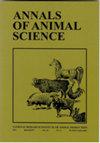尼罗罗非鱼日粮中添加黑兵蝇幼虫粉对水质变化、生长性能和健康状况的响应
IF 2.2
4区 农林科学
Q1 Veterinary
引用次数: 0
摘要
随着集约化水产养殖生产的不断增加,寻找营养、环境和经济上可行的鱼粉(FM)替代品是一种永无止境的方法。因此,本研究考察了在尼罗罗非鱼(Oreochromis niloticus)日粮中使用黑兵蝇(Hermetia illucens)幼虫粉(BSFM)作为替代蛋白质对氮废物、动物技术性能、体成分和血液生化参数的影响。选取尼罗罗非鱼鱼种315尾(4.11±0.12 g/尾),分为7个处理,每3个重复。放养于50 × 40 × 30 cm的玻璃水族箱中;每缸60升),每缸15条鱼。试验饲粮中添加0、5、10、15、20、25和30%的BSFM替代饲料,每日2次,至表观饱足,持续84 d。结果表明,与对照组相比,BSFM替代显著(p = 0.001)改善了水质,降低了总氨、NH3和NO2水平。随着BSFM添加水平增加至25% (p分别为0.001、0.017和0.001),生长性能、饲料系数和存活率均有所提高。然而,当添加量增加到30%时,实验鱼的动物技术性能开始下降。BSFM添加至25%时,血液生化指标显著增强(p≤0.01)。添加BSFM后,肝脏和肾脏功能指标得到改善(p = 0.001)。经济评价表明,提高鱼饲料中BSFM的水平可降低饲料成本和鱼的增重。目前的研究强调了在减少水体氮废物水平、改善生长性能和健康状况以及提高商业罗非鱼饲料的经济可行性方面,BSFM作为鱼粉替代品的潜在环境效益。本文章由计算机程序翻译,如有差异,请以英文原文为准。
Water quality change, growth performance, health status in response to dietary inclusion of black soldier fly larvae meal in the diet of Nile tilapia, Oreochromis niloticus
Abstract With increasing intensive aquaculture production, the search for nourishing, environmentally, and economically viable fishmeal (FM) alternative is an endless approach. Therefore, the present study examines the use of black soldier fly, Hermetia illucens , larvae meal (BSFM) as an alternative protein for FM in the diet of Nile tilapia, Oreochromis niloticus, on nitrogen wastes, zootechnical performance, body composition, and hematobiochemical parameters. A total of 315 Nile tilapia fingerlings (4.11± 0.12 g/fish) were divided into seven treatments in triplicate. The fish were stocked in glass aquaria (50 × 40 × 30 cm; 60 L each) at a rate of 15 fish per aquaria. Experimental diets contained BSFM at increasing levels of 0, 5, 10, 15, 20, 25, and 30% as FM replacers were offered twice daily to apparent satiation for 84 days. The results revealed that BSFM replacements significantly (p = 0.001) enhance water quality and reduce the total ammonia, NH3, and NO2 levels compared to the control. The growth performance, feed conversion ratio, and survival were improved with increasing BSFM meal inclusion levels up to 25% (p = 0.001, 0.017, and 0.001 respectively). However, the zootechnical performance of the experimental fish started to decline with increasing replacement levels to 30%. Also, by an increase in BSFM level to 25%, hematobiochemical markers were considerably (p ≤ 0.01) enhanced. The liver and kidney function indicators improved (p = 0.001) with dietary BSFM. The economic evaluation revealed that feed costs and fish weight gain were decreased by increasing BSFM levels in fish diets. The current study highlighted the potential environmentally beneficial use of BSFM as an FM replacer in terms of reducing water nitrogen waste levels and improving growth performance, health status, and enhancing the economic feasibility of the commercial tilapia diet.
求助全文
通过发布文献求助,成功后即可免费获取论文全文。
去求助
来源期刊

Annals of Animal Science
AGRICULTURE, DAIRY & ANIMAL SCIENCE-
CiteScore
3.80
自引率
5.30%
发文量
138
期刊介绍:
Annals of Animal Science accepts original papers and reviews from the different topics of animal science: genetic and farm animal breeding, the biology, physiology and reproduction of animals, animal nutrition and feedstuffs, environment, hygiene and animal production technology, quality of animal origin products, economics and the organization of animal production.
 求助内容:
求助内容: 应助结果提醒方式:
应助结果提醒方式:


